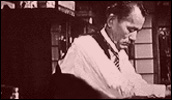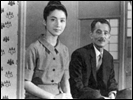An Autumn Afternoon
- Year
- 1962
- Original title
- Sanma no Aji
- Japanese title
- 秋刀魚の味
- Director
- Cast
- Running time
- 108 minutes
- Published
- 11 February 2002


by Jasper Sharp
Despite being loudly praised back at home, throughout the thirty-six year period over which he worked as a director Yasujiro Ozu's films were considered far too Japanese for Western audiences to appreciate.
A major practitioner of the gendai-geki genre of films about everyday life, his films were immensely popular with both the general public and the critics in Japan, with a grand total of six of them voted to the number one spot in Kinema Jumpo's annual awards over the course of his career. However, it was generally assumed that Ozu's cheery white-collar humanism would have little resonance with viewers in the rest of the world. Subsequently his films were not widely released abroad and during his lifetime the director never received the same worldwide recognition as such contemporaries as Akira Kurosawa and Kenji Mizoguchi.
Nowadays Ozu's films regularly appear on critics' "greatest films of all time" lists and the director is now firmly canonised amongst the Kubricks and Fellinis as one of the great figures of twentieth century world cinema. His immaculately restrained editing technique and a distinctive visual style comprised of flat frontal compositions with the actors often facing the audience and the camera kept at uniformly low height, shooting from just below waist level (as is often mentioned, as if the viewer is regarding the scene from the seated viewpoint of the tatami mat), have been subjected to a great deal of analysis over the years. His trademark Zen-like minimalism is often held up as a direct reaction to the more melodramatic cinematic style of Western films of the time (as embraced by Kurosawa in such films as The Seven Samurai / Shichinin no Samurai, 1954), an exemplar of cinematic purity firmly based within the aesthetic tradition of the other Japanese arts.
I can't help thinking that this constant focus on technique and the "Japaneseness" of Ozu's oeuvre has come at the cost of shielding off casual viewers, seemingly reducing his appeal to academics and high-brow film buffs. The art has been so lost in the focus on the artistry that it distracts from exactly what made these films so popular with the audiences of the time in the first place - their simplicity. Certainly films such as Tokyo Story (Tokyo Monogatari, 1953) and Late Spring (Banshun, 1949) have much to offer modern audiences, and I would strongly advise any Midnight Eye reader not to be intimidated by Ozu's lofty reputation - his films are actually a lot more accessible than one might think. After all, great directors are not labelled great directors for nothing.
Ozu's final film, An Autumn Afternoon, made one year before his death in 1963, may not be recognised as one of his greatest works, but it's a remarkably watchable piece that sums up the themes and approach of its director perfectly. Beginning with a 40th anniversary school reunion in the saké bar that forms one of the film's main locations, the basic scenario has Hirayama (played by Ryu, a regular actor for Ozu, best known for his roles in Tokyo Story and The Flavour of Green Tea Over Rice / Ochazuke No Aji) as the calmly authoritative patriarch at the film's centre trying to find a suitable spouse with whom to marry off his 23-year old daughter Michiko (Iwashita). One of his sons, Koichi, has already married and his youngest, Kazuo, looks set to fly the nest one day. One of the secretaries at the large company where he works is about to leave and settle down to a life of married bliss too, and Hirayama seems anxious to escape the predicament of his old schoolyard acquaintances Hyotan (Tono), who runs a tatty noodle bar with a burly daughter who is now well past her sell-by date ("Ah, she's not so pretty!", he drunkenly proclaims with a screwed up face to his assembled former classmates). However, attempts at finding a suitable husband for Michiko initially seem slim. Where do you find an eligible bachelor when you need one?
An Autumn Afternoon is the type of film that was encouraged by the head of Shochiku, Shiro Kido, possessing the same "Ofuna flavour" that typified the studio's output during the 50s, coming at the tail end of the Golden Age of Japanese Cinema at a time when theatres were losing admissions hand over fist to the newly arrived medium of television (whose impact on family life was dealt with by Ozu a few years earlier in Good Morning / Ohayo). Co-scripted with long-term collaborator Kogo Noda, as is usual with Ozu, plot is reduced to a bare minimum. Though the story revolves around the central axis of Hirayama, a good deal of the film is given over to the other characters, charting the ups and downs of their daily existence the film almost existing entirely in the form of a series of vignettes.
This apparent lack of focus and purpose may seem off-putting at first, but by avoiding the contrivances of traditional dramatic narratives whilst sketching out a touching portrait of everyday family life, Ozu creates a world that gives the impression of stretching far beyond the limiting vista of the cinema screen. Coupled with his meticulously simplistic visual language, which eschews even such basic techniques as moving cameras, cross-scene dissolves and fades, it is this aspect that gives all of Ozu's films such a timeless, universal appeal.
Ozu passed away in 1963, halfway through making Radishes and Carrots (Daikon to Ninjin), a film that was completed by Minoru Shibuya the following year. Whether he would have been able to continue holding his own in a rapidly changing film market is debatable, as by the time of An Autumn Afternoon, his easy-going light-hearted approach was already becoming superseded by a new generation of filmmakers crying for a stronger focus on the individual. One of whom, Shohei Imamura, a former assistant to Ozu, seemed to be rebelling completely against his mentor, citing the director's passive, rose-coloured view of society as unrepresentative of the Japanese spirit. In 1964, Imamura's Intentions of Murder (Akai Satsui) put an entirely different slant on an entirely different family unit. One Golden Age of Japanese cinema had ended, another one, arguably, was already well under way.